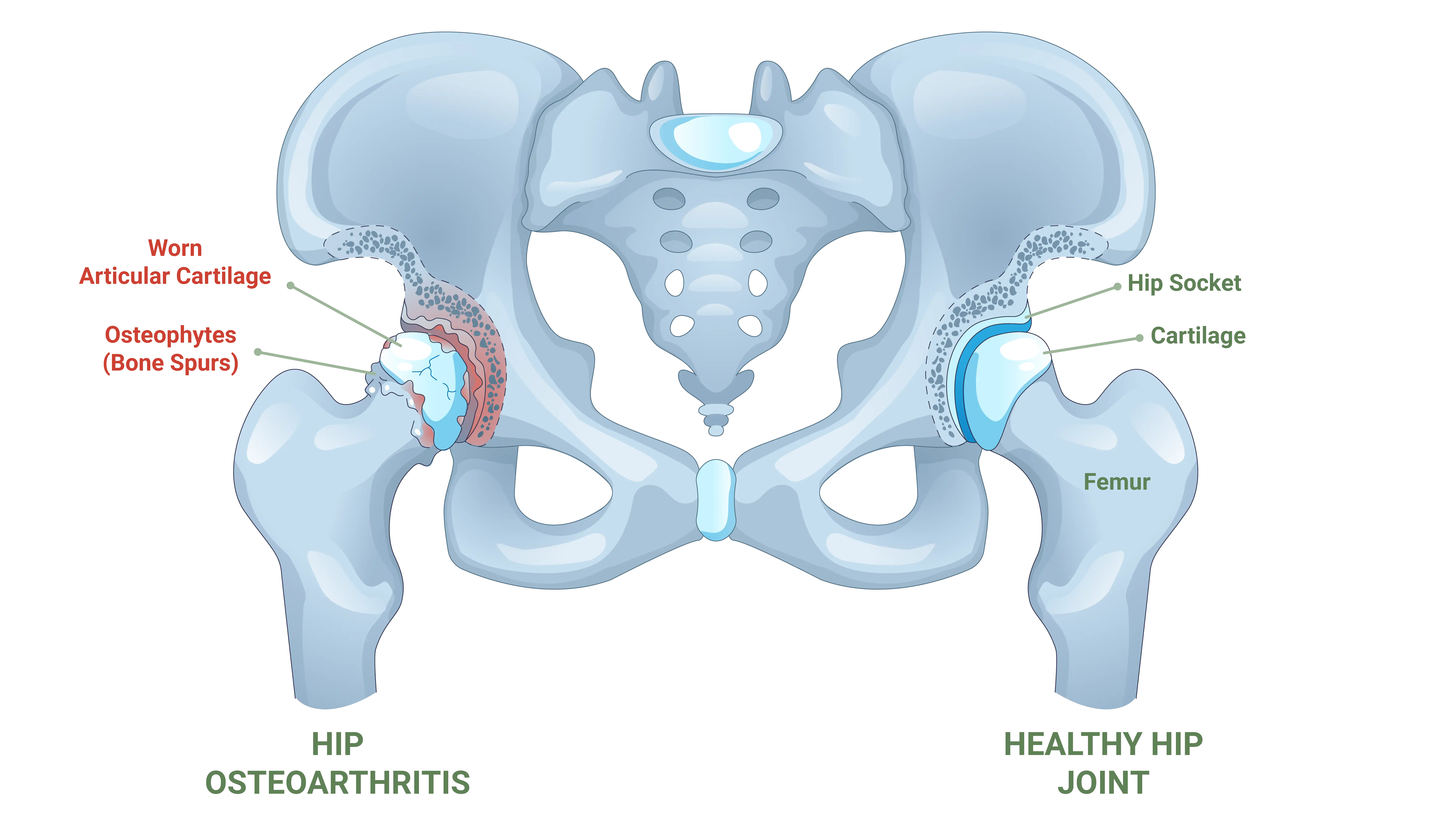Hip arthritis pain is commonly felt in the hip joint, but can also be experienced in other areas of the body. Recognizing where this pain can be felt helps in identifying symptoms early and guiding effective treatment. In this post, we’ll explore these pain locations and offer strategies for relief.
Key Takeaways
- Hip arthritis pain is commonly caused by osteoarthritis, a condition that can significantly limit mobility and impact daily life.
- Pain may be felt in the hip joint, groin, lower back, and outer thigh. Symptoms can develop gradually or appear suddenly, underscoring the importance of early recognition.
- Management options range from conservative treatments like physical therapy and lifestyle changes to surgical interventions such as hip replacement when non-surgical options are no longer effective.
Hip Arthritis Overview
Hip arthritis refers to inflammation and degeneration of the hip joint, most commonly due to osteoarthritis, a condition where the cartilage that cushions the joint wears over time.

This degeneration can result from age-related changes, injuries, genetic factors, or lifestyle choices. As the cartilage wears away, bone may rub against bone, causing stiffness, reduced mobility, and pain.
Understanding Hip Arthritis Pain
Pain from hip arthritis can vary in intensity and character. It may be sharp or dull and is often accompanied by stiffness and joint inflammation. These symptoms can make everyday movements, such as bending, walking, and rising from a chair, into daily challenges.
Understanding the nature of hip arthritis pain helps guide effective treatment. Differentiating between gradual onset and sudden pain, identifying common symptoms, and pinpointing typical pain locations offers valuable insights into how to manage it.
Gradual Onset vs. Sudden Pain
Hip arthritis pain can develop gradually over many years, often creeping up unnoticed until it’s significant enough to affect daily activities. This progression is typical of osteoarthritis, where the cartilage breaks down slowly over time.
In contrast, sudden hip pain can emerge after an injury or trauma. This type of pain often brings immediate discomfort and mobility limitations.
Whether the pain develops gradually or suddenly, recognizing the signs early and seeking appropriate care can significantly improve long-term outcomes.
Common Symptoms
Osteoarthritis of the hip may present through a range of physical symptoms, with pain being the most prominent indicator. Common symptoms include:
- Pain that may worsen with movement and weight-bearing activities
- Reduced range of motion
- Difficulty performing everyday tasks
- Joint stiffness and discomfort due to inflammation
- Limping or difficulty walking as the condition progresses
Additional symptoms may include joint tenderness, swelling, or a grinding sensation during movement (crepitus). These symptoms can interfere with mobility and diminish quality of life if not properly addressed.
Primary Locations of Hip Arthritis Pain
Hip arthritis pain is not limited to one specific area. While the hip joint itself is often the primary source, the pain may radiate to nearby regions. Recognizing the key pain locations can help in accurately diagnosing the condition and guiding appropriate treatment strategies.
Pain in and Around the Hip Joint
Pain directly within the hip joint is a hallmark symptom of hip arthritis. The discomfort is most commonly described as dull or aching and may be accompanied by joint tenderness, swelling, or a grinding sensation during movement (crepitus).
Referred Pain from Hip Arthritis
In many cases, hip arthritis causes referred pain, where discomfort is experienced in areas farther from the actual joint.
The groin and outer thigh regions are some of the most common areas where hip arthritis pain is felt. Pain may worsen after prolonged activity or after being still for an extended time (such as waking up in the morning).
Although less common, other neighboring areas where hip arthritis can cause pain include the lower back, knees, ankles, and feet. Inflammation may also radiate down the legs, leading to discomfort, stiffness, and reduced range of motion.
Recognizing that hip arthritis can produce widespread pain helps in forming a complete, accurate diagnosis.
Diagnostic Methods for Hip Arthritis Pain
Diagnosing hip arthritis involves a combination of physical exams and imaging tests. These methods help identify the affected areas and the severity of the condition, making it possible to tailor an effective treatment plan.
Physical Examination
During a physical examination, your doctor will assess the hip for tenderness, range of motion, and swelling. You will also be asked about your medical history, including any prior injuries, current symptoms, and overall health status. This information helps rule out other possible causes of pain and supports a more accurate diagnosis.
Imaging Tests
Imaging tests such as X-rays and MRIs play an important role in confirming the diagnosis and assessing the severity of the condition.
X-rays can reveal joint space narrowing, changes in bone structure, and the formation of bone spurs, which help to indicate osteoarthritis. MRI scans provide detailed images of soft tissues, including cartilage, ligaments, and tendons. These are especially useful for detecting early-stage arthritis and identifying issues not visible on X-rays.
Together, physical exams and imaging tests provide a comprehensive view of the joint’s condition and help guide appropriate next steps in treatment.
Managing Hip Arthritis Pain
Managing hip arthritis pain typically involves a combination of conservative treatments, lifestyle changes, and, in some cases, surgery. These strategies aim to reduce pain, improve mobility, and enhance overall quality of life.
Conservative Treatments
Non-surgical treatment options are often the first step in managing hip arthritis. These may include physical therapy, medications, and assistive devices.
A physical therapist can help increase range of motion, flexibility, and strengthen muscles surrounding the hip and leg. Following a physical therapy program can result in pain reduction and improved mobility.
Medications such as nonsteroidal anti-inflammatory drugs (NSAIDs) may be added to the treatment plan to reduce pain and inflammation. Assistive devices may be recommended to reduce strain on the hip joint and support mobility.
Often, these conservative treatments are the first line of defense against hip arthritis pain, helping manage symptoms and maintain an active lifestyle.
Lifestyle Changes
Lifestyle changes play an essential role in managing hip arthritis pain. Some of these key lifestyle changes include weight management and engaging in low-impact exercise.
Maintaining a healthy weight helps reduce pressure and stress on the hip joint. Additionally, regularly engaging in gentle, low-impact exercises like swimming and walking can improve flexibility and mobility. It’s important to avoid high-impact activities like contact sports, as these can aggravate symptoms.
Surgical Treatments
When conservative treatments fail to provide relief, surgical options such as hip replacement or hip resurfacing may be considered.
Hip replacement surgery involves replacing the damaged hip joint with an artificial one. Hip resurfacing involves trimming damaged bone and replacing it with a metal cap, preserving more of the natural joint.
The goal of both these surgeries is to restore strength, mobility, and range of motion.
When to Seek Medical Attention
If hip pain persists for more than a few weeks or begins to interfere with your daily activities, consider consulting an experienced hip specialist. Persistent pain, stiffness, or reduced mobility may indicate hip arthritis or another joint condition that requires evaluation.
Early medical attention allows for timely diagnosis and treatment, helping to prevent the progression of symptoms and reduce the risk of further joint damage.
Summary
Understanding where hip arthritis pain is felt and recognizing its symptoms can significantly improve your ability to manage this condition. Pain commonly occurs in the hip joint, groin, and outer thigh, but it also may radiate to the lower back, knees, and in some cases, the ankles and feet.
Early diagnosis through a combination of physical examination and imaging tests can lead to more effective management strategies. Whether through conservative treatments, lifestyle changes, or surgical intervention, there are numerous ways to alleviate pain and improve quality of life.
Frequently Asked Questions
What is hip arthritis?
Hip arthritis is a condition in which the cartilage that cushions the hip joint gradually wears down, leading to pain, stiffness, and reduced mobility. The most common type is osteoarthritis, which typically develops with age, but can also result from injury and overuse. As the cartilage deteriorates, bones may rub against each other, causing pain and limiting range of motion.
What is referred pain in relation to hip pain?
Referred pain occurs when discomfort felt in one region is actually originating from another area. For example, hip arthritis can be experienced not just in the hip, but in the groin, outer thigh, lower back, knees, ankles, and feet. Identifying the true source of pain is essential for effective treatment.
When should someone seek medical attention for hip pain?
Consider seeking medical attention for hip pain if it becomes severe, disrupts daily activities, causes swelling, or fails to improve after several weeks. Prompt intervention is key to proper diagnosis and treatment.
What diagnostic methods are used to determine the cause of hip pain?
Diagnosing hip pain typically involves reviewing your medical history, performing a physical exam, and using imaging tests such as X-rays or MRI scans. These tools provide a comprehensive view of the joint and surrounding tissues.





